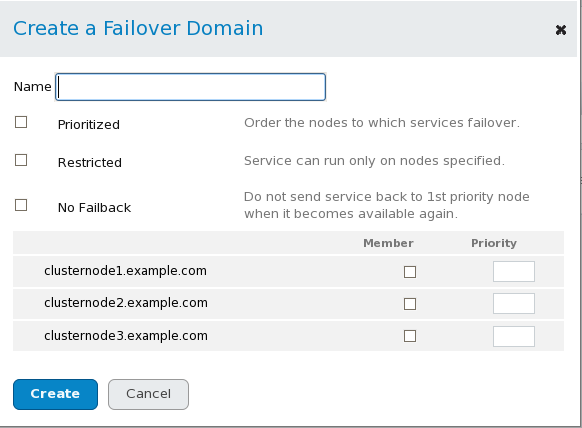3.7. Configuring a Failover Domain
A failover domain is a named subset of cluster nodes that are eligible to run a cluster service in the event of a node failure. A failover domain can have the following characteristics:
Unrestricted — Allows you to specify that a subset of members are preferred, but that a cluster service assigned to this domain can run on any available member.
Restricted — Allows you to restrict the members that can run a particular cluster service. If none of the members in a restricted failover domain are available, the cluster service cannot be started (either manually or by the cluster software).
Unordered — When a cluster service is assigned to an unordered failover domain, the member on which the cluster service runs is chosen from the available failover domain members with no priority ordering.
Ordered — Allows you to specify a preference order among the members of a failover domain. The member at the top of the list is the most preferred, followed by the second member in the list, and so on.
Failback — Allows you to specify whether a service in the failover domain should fail back to the node that it was originally running on before that node failed. Configuring this characteristic is useful in circumstances where a node repeatedly fails and is part of an ordered failover domain. In that circumstance, if a node is the preferred node in a failover domain, it is possible for a service to fail over and fail back repeatedly between the preferred node and another node, causing severe impact on performance.
The failback characteristic is applicable only if ordered failover is configured.
Changing a failover domain configuration has no effect on currently running services.
Failover domains are not required for operation.
By default, failover domains are unrestricted and unordered.
In a cluster with several members, using a restricted failover domain can minimize the work to set up the cluster to run a cluster service (such as httpd), which requires you to set up the configuration identically on all members that run the cluster service). Instead of setting up the entire cluster to run the cluster service, you must set up only the members in the restricted failover domain that you associate with the cluster service.
To configure a preferred member, you can create an unrestricted failover domain comprising only one cluster member. Doing that causes a cluster service to run on that cluster member primarily (the preferred member), but allows the cluster service to fail over to any of the other members.
The following sections describe adding, modifying, and deleting a failover domain:
3.7.1. Adding a Failover Domain
To add a failover domain, follow the steps in this section.
From the cluster-specific page, you can configure Failover Domains for that cluster by clicking on along the top of the cluster display. This displays the failover domains that have been configured for this cluster.
In the Create a Failover Domain window, specify a failover domain name at the text box.
The name should be descriptive enough to distinguish its purpose relative to other names used in your cluster.
To enable setting failover priority of the members in the failover domain, click the checkbox. With checked, you can set the priority value, , for each node selected as members of the failover domain.
To restrict failover to members in this failover domain, click the checkbox. With checked, services assigned to this failover domain fail over only to nodes in this failover domain.
To specify that a node does not fail back in this failover domain, click the checkbox. With checked, if a service fails over from a preferred node, the service does not fail back to the original node once it has recovered.
Configure members for this failover domain. Click the checkbox for each node that is to be a member of the failover domain. If is checked, set the priority in the text box for each member of the failover domain.
Click Create. This displays the Failover Domains page with the newly-created failover domain displayed. A message indicates that the new domain is being created. Refresh the page for an updated status.


